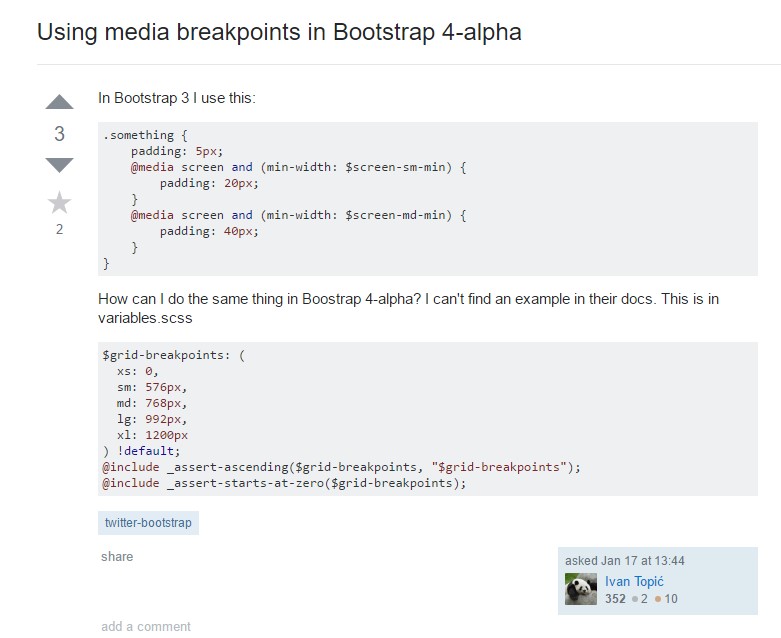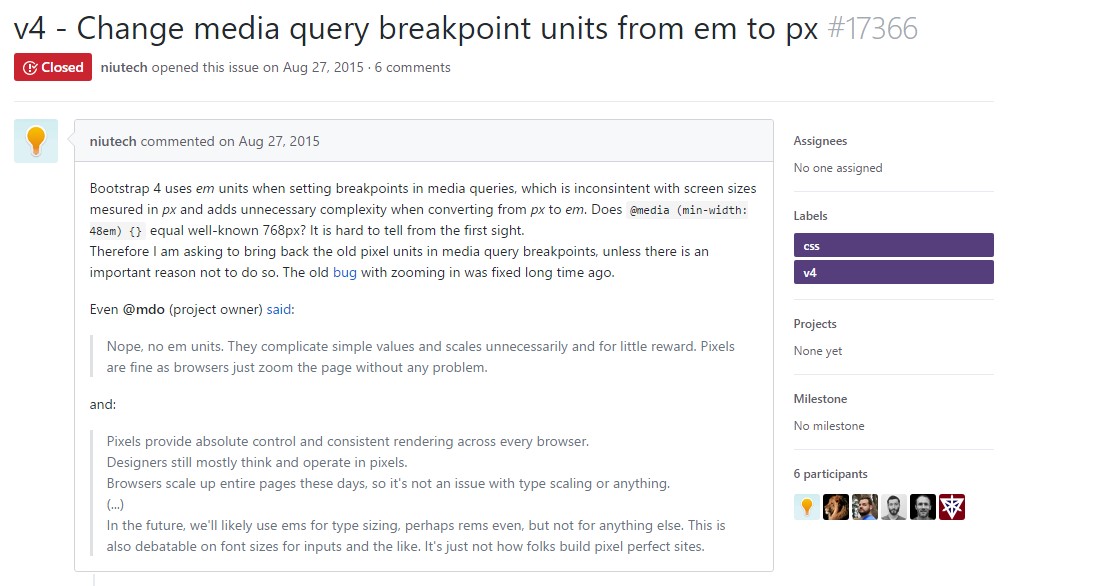Bootstrap Breakpoints Css
Intro
Taking in concern all of the possible display sizes where our online pages could eventually present it is essential to make up them in a way providing undisputed sharp and highly effective appearance-- commonly utilizing the aid of a powerful responsive framework like easily the most well-known one-- the Bootstrap framework which latest edition is now 4 alpha 6. However what it truly handles to help the webpages pop up terrific on any sort of display screen-- let us have a look and notice.
The main standard in Bootstrap typically is positioning certain system in the countless practical device display sizes (or viewports) setting them into a few ranges and styling/rearranging the material properly. These are as well termed grid tiers or else display screen dimensions and have advanced quite a little bit via the numerous variations of the absolute most well-known recently responsive framework around-- Bootstrap 4. ( useful source)
How you can use the Bootstrap Breakpoints Default:
Generally the media queries become defined with the following structure
@media ( ~screen size condition ~) ~ styling rules to get applied if the condition is met ~min-width: 768pxmin-width: 768pxVariations of Bootstrap versions
Within Bootstrap 4 in contrast to its predecessor there are actually 5 display screen sizes however because the current alpha 6 build-- basically only 4 media query groups-- we'll get back to this in just a sec. Given that you probably realise a
.row.col -Display scales
The display screen sizes in Bootstrap generally employ the
min-widthExtra small – widths under 576px –This screen actually doesn't have a media query but the styling for it rather gets applied as a common rules getting overwritten by the queries for the widths above. What's also new in Bootstrap 4 alpha 6 is it actually doesn't use any size infix – so the column layout classes for this screen size get defined like
col-6Extra small-- sizes below 576px-- This screen in fact doesn't have a media query though the designing for it rather gets employed as a usual regulations being overwritten due to the queries for the sizes just above. What's as well fresh inside of Bootstrap 4 alpha 6 is it certainly doesn't make use of any scale infix-- and so the column format classes for this kind of display screen scale get identified like
col-6Small screens-- utilizes
@media (min-width: 576px) ...-sm-.col-sm-6Medium display screens-- employs
@media (min-width: 768px) ...-md-.col-md-6Large displays - works with
@media (min-width: 992px) ...-lg-And lastly-- extra-large display screens -
@media (min-width: 1200px) ...-xl-Responsive breakpoints
Due to the fact that Bootstrap is developed to become mobile first, we make use of a handful of media queries to generate sensible breakpoints for programs and styles . These Bootstrap Breakpoints Responsive are typically based on minimum viewport widths as well as allow us to size up factors while the viewport changes. ( more helpful hints)
Bootstrap mainly utilizes the following media query varies-- or breakpoints-- in source Sass data for style, grid system, and components.
// Extra small devices (portrait phones, less than 576px)
// No media query since this is the default in Bootstrap
// Small devices (landscape phones, 576px and up)
@media (min-width: 576px) ...
// Medium devices (tablets, 768px and up)
@media (min-width: 768px) ...
// Large devices (desktops, 992px and up)
@media (min-width: 992px) ...
// Extra large devices (large desktops, 1200px and up)
@media (min-width: 1200px) ...Due to the fact that we compose source CSS in Sass, all of media queries are actually accessible by Sass mixins:
@include media-breakpoint-up(xs) ...
@include media-breakpoint-up(sm) ...
@include media-breakpoint-up(md) ...
@include media-breakpoint-up(lg) ...
@include media-breakpoint-up(xl) ...
// Example usage:
@include media-breakpoint-up(sm)
.some-class
display: block;We in some cases use media queries that work in the some other way (the granted screen size or even more compact):
// Extra small devices (portrait phones, less than 576px)
@media (max-width: 575px) ...
// Small devices (landscape phones, less than 768px)
@media (max-width: 767px) ...
// Medium devices (tablets, less than 992px)
@media (max-width: 991px) ...
// Large devices (desktops, less than 1200px)
@media (max-width: 1199px) ...
// Extra large devices (large desktops)
// No media query since the extra-large breakpoint has no upper bound on its widthOnce more, such media queries are also readily available via Sass mixins:
@include media-breakpoint-down(xs) ...
@include media-breakpoint-down(sm) ...
@include media-breakpoint-down(md) ...
@include media-breakpoint-down(lg) ...There are additionally media queries and mixins for aim a specific section of screen scales using the minimum and highest Bootstrap Breakpoints Grid sizes.
// Extra small devices (portrait phones, less than 576px)
@media (max-width: 575px) ...
// Small devices (landscape phones, 576px and up)
@media (min-width: 576px) and (max-width: 767px) ...
// Medium devices (tablets, 768px and up)
@media (min-width: 768px) and (max-width: 991px) ...
// Large devices (desktops, 992px and up)
@media (min-width: 992px) and (max-width: 1199px) ...
// Extra large devices (large desktops, 1200px and up)
@media (min-width: 1200px) ...These types of media queries are likewise provided by means of Sass mixins:
@include media-breakpoint-only(xs) ...
@include media-breakpoint-only(sm) ...
@include media-breakpoint-only(md) ...
@include media-breakpoint-only(lg) ...
@include media-breakpoint-only(xl) ...Also, media queries may span multiple breakpoint widths:
// Example
// Apply styles starting from medium devices and up to extra large devices
@media (min-width: 768px) and (max-width: 1199px) ...
<code/>
The Sass mixin for focus on the same screen size range would definitely be:
<code>
@include media-breakpoint-between(md, xl) ...Conclusions
In addition to describing the size of the page's features the media queries happen around the Bootstrap framework ordinarily becoming defined through it
- ~screen size ~Check a number of online video tutorials relating to Bootstrap breakpoints:
Connected topics:
Bootstrap breakpoints main documentation

Bootstrap Breakpoints issue

Transform media query breakpoint systems from 'em' to 'px'
